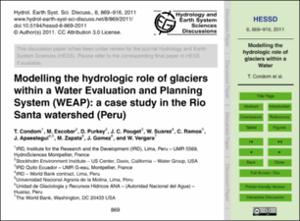Mostrar el registro sencillo del ítem
Modelling the hydrologic role of glaciers within a Water Evaluation and Planning System (WEAP): a case study in the Rio Santa watershed (Peru)
| dc.contributor.author | Condom, Thomas | |
| dc.contributor.author | Escobar, Marisa | |
| dc.contributor.author | Purkey, David | |
| dc.contributor.author | Pouge, Jean Christophe | |
| dc.contributor.author | Suarez, Wilson | |
| dc.contributor.author | Apaestegui, James | |
| dc.contributor.author | Gómez López, Jesús | |
| dc.contributor.author | Zapata Luyo, Marco Alfonso | |
| dc.contributor.author | Vergara, W. | |
| dc.coverage.spatial | Cordillera Blanca | |
| dc.date.accessioned | 2019-01-16T21:12:22Z | |
| dc.date.available | 2019-01-16T21:12:22Z | |
| dc.date.issued | 2011 | |
| dc.identifier.citation | Condom, T., Escobar, M., Purkey, D. et. al (2011) Modelling the hydrologic role of glaciers within a Water Evaluation and Planning System (WEAP): a case study in the Rio Santa watershed (Peru). Hydrology and Earth System Sciences, 8(1), 869–916. doi: https://doi.org/10.5194/hessd-8-869-2011 | es_PE |
| dc.identifier.issn | ISSN: 1027-5606, ESSN: 1607-7938 | es_PE |
| dc.identifier.uri | https://hdl.handle.net/20.500.12543/3266 | |
| dc.description | Original abstract: For the past 30 years, a process of glacier retreat has been observed in the Andes, raising alarm among regional water resources managers. The purpose of this paper is to develop a model of the role of Andean glaciers in the hydrology of their associated watersheds, which is appropriate for application at a river basin scale, with an eye towards creating an analytical tool that can be used to assess the water management implications of possible future glacier retreat. While the paper delves deeply into our formulation of a glacier module within a water resources management modelling system, the widely subscribed Water Evaluation and Planning System (WEAP), the originality of our work lies less in the domain of glaciology and more in how we apply an existing reduced form representation of glacier evolution within a model of the climate-glacier-hydrology-water management continuum. Key insights gained pertain to appropriate ways to deploy these reduced form representations in a relatively data poor environment and to effectively integrate them into a modelling framework that places glaciers within a wider water management context. The study area is the Rio Santa watershed in Peru which contains many of the expansive glaciers of the singular Cordillera Blanca. The specific objectives of this study included: (i) adequately simulating both monitored glacier retreat and observed river flows from the last forty years using historical climate time series as model input; (ii) quantifying the proportion of river flow in the Rio Santa produced from melting glaciers during this period; (iii) estimating the historical contribution of groundwater accretions to river flows; and (vi) reproducing a reasonable simulation of recent hydropower operations in the Rio Santa system. In pursuit objective (i), a split sample calibration-validation of the model was conducted by comparing the simulated glacier area to Landsat images taken in 1987 and 1998 and observed and simulated river flow at 16 control points in the Rio Santa watershed. At the global scale of the watershed, the glacier retreat is correctly simulated for the period 1970/1999 with a calculated retreat equals to -23% when the observed retreat is of -24%. Having established that the model can respond to these scientific objectives, the ultimate goal of the study was to demonstrate how this integrated modelling system can be used as a decision support tool to assist in planning water management adaptation to climate change. This sort of integrated assessment is required to adapt water resources management in the Andes to a~range of future climatic conditions, improving the resilience of developing Andean economies such Peru's in the face of a major drive of global change. | es_PE |
| dc.description | Artículo en acceso abierto | es_PE |
| dc.description.abstract | Refiere que el proceso de retirada de glaciares en los Andes observado durante los últimos 30 años ha alarmado a los administradores regionales de recursos hídricos. El propósito de este documento es desarrollar un modelo del papel de los glaciares andinos en la hidrología de sus cuencas hidrográficas asociadas, que es apropiado para su aplicación a escala de cuenca, con miras a crear una herramienta analítica que pueda utilizarse para evaluar la Implicaciones de la gestión del agua de un posible futuro retiro de glaciares. Señala que el estudio profundiza en la formulación de un módulo glaciar dentro de un sistema de modelado de gestión de recursos hídricos, el Sistema de Evaluación y Planificación del Agua (WEAP) ampliamente suscrito, sin embargo, la originalidad del trabajo radica menos en cómo se aplica una representación de forma reducida existente de la evolución de los glaciares dentro de un modelo continuo de gestión de agua, hidrología y glaciares. | es_PE |
| dc.format | application/pdf | es_PE |
| dc.language.iso | eng | es_PE |
| dc.publisher | EGU | es_PE |
| dc.relation.ispartofseries | Hydrology and Earth System Sciences, January 2016, Volume 20, Issue 1, pp 125-141 | es_PE |
| dc.relation.uri | http://www.hydrol-earth-syst-sci-discuss.net/8/869/2011/ | |
| dc.rights | info:eu-repo/semantics/openAccess | es_PE |
| dc.rights | Attribution-NonCommercial-NoDerivatives 4.0 International | * |
| dc.rights.uri | https://creativecommons.org/licenses/by-nc-nd/4.0/ | * |
| dc.source | Autoridad Nacional del Agua | es_PE |
| dc.source | Repositorio institucional - ANA | es_PE |
| dc.subject | Cambio climático | es_PE |
| dc.subject | Conservación de glaciares | es_PE |
| dc.subject | Riesgos de disponibilidad hídrica | es_PE |
| dc.subject | Monitoreo de lagunas y glaciares | es_PE |
| dc.title | Modelling the hydrologic role of glaciers within a Water Evaluation and Planning System (WEAP): a case study in the Rio Santa watershed (Peru) | es_PE |
| dc.type | info:eu-repo/semantics/article | es_PE |
| dc.identifier.doi | https://doi.org/10.5194/hessd-8-869-2011 | es_PE |








